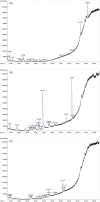Chemical composition and antibacterial activity of Berberis vulgaris (barberry) against bacteria associated with caries
- PMID: 33325156
- PMCID: PMC8404507
- DOI: 10.1002/cre2.379
Chemical composition and antibacterial activity of Berberis vulgaris (barberry) against bacteria associated with caries
Abstract
Objectives: The aim of this in-vitro study was to determine the antimicrobial capacity of a Berberis vulgaris plant extract on the bacteria being associated with caries including, Streptococcus mutans, S. sobrinus, S. sanguinis, S. salivaris and Lactobacillus rhamnosus.
Material and methods: Chlorhexidine 2% (CHX) mouthwash and ampicillin (10 μg/disk) were applied as positive control groups. Inhibition zone, minimum inhibitory concentration (MIC) and minimum bactericidal concentration (MBC) related to stem, leaf and fruit of B. vulgaris plant were recorded for every five bacteria. Data were analyzed using SPSS ver. 22, one-way ANOVA repeated measure and post hoc Tukey statistical test. The significance level was set at p < 0.05.
Results: There were no significant differences between the antimicrobial capacity of the positive controls and the extract from the stem and fruit of B. vulgaris (p > 0.05). The MIC values of the extract from the stem were significantly lower against S. sobrinus (64 μg/ml) and L. rhamnosus (128 μg/ml). The MIC value of the extract against S. mutans was significantly lower in the fruit group (64 μg/mL). The MBC value of the extract against S. sobrinus and L. rhamnosus was significantly lower in the stem group (128 μg/ml). The MBC value against S. mutans was significantly lower in the fruit group (128 μg/ml).
Conclusions: The results showed that CHX and B. vulgaris plant extract have similar antimicrobial activity against bacteria being associated with caries. Therefore, B. vulgaris, which shows antibacterial capacity, could be considered for further investigation as a safe, phytotherapeutic mouthwash to prevent dental caries.
Keywords: Berberis; antimicrobial activity; berberine; dental caries; medicinal plant; natural medicine.
© 2020 The Authors. Clinical and Experimental Dental Research published by John Wiley & Sons Ltd.
Conflict of interest statement
The authors declare that there are no conflicts of interest regarding the publication of this article.
Figures
References
-
- Amirzade‐Iranaq, M. H., & Masoumil, S. M. R. (2017). 50: Effect of low‐level laser therapy in the treatment of burning mouth syndrome: A systematic review and meta‐analysis. BMJ Open, 7(1).
-
- Bagheri, S. M., Hedesh, S. T., Mirjalili, A., & Dashti‐R, M. H. (2016). Evaluation of anti‐inflammatory and some possible mechanisms of antinociceptive effect of Ferula assa foetida oleo gum resin. Journal of Evidence‐Based Complementary & Alternative Medicine, 21(4), 271–276. 10.1177/2156587215605903. - DOI - PubMed
Publication types
MeSH terms
Substances
LinkOut - more resources
Full Text Sources
Medical


